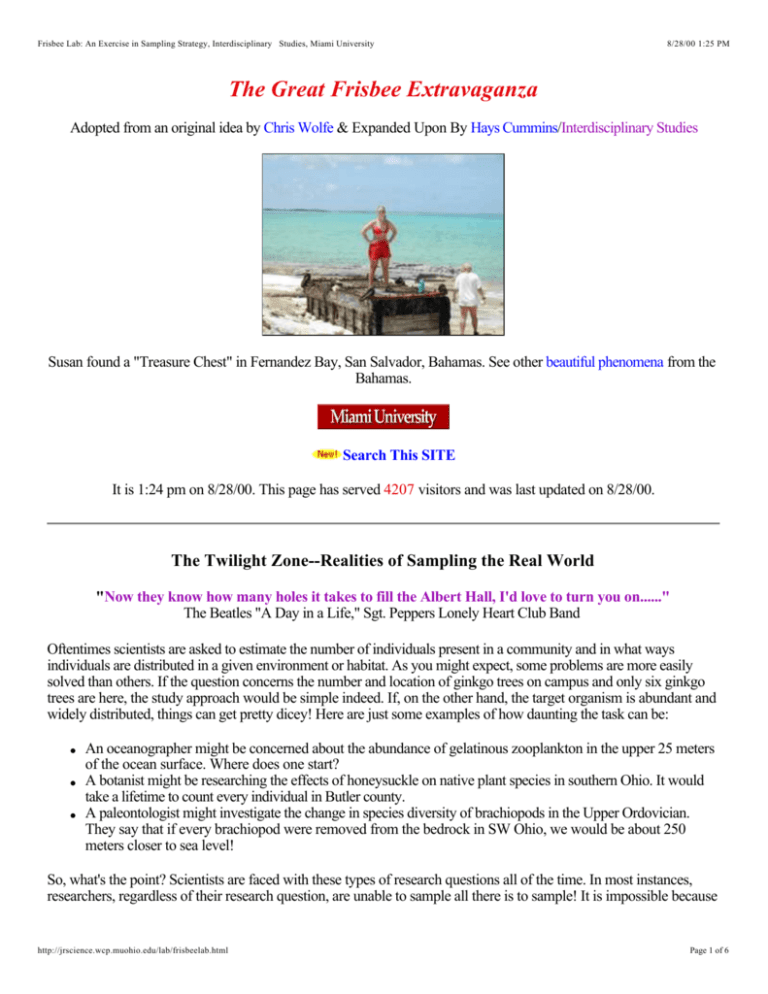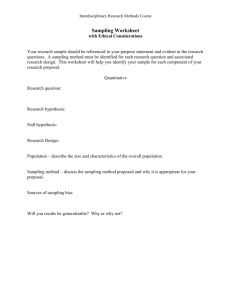
Frisbee Lab: An Exercise in Sampling Strategy, Interdisciplinary Studies, Miami University
8/28/00 1:25 PM
The Great Frisbee Extravaganza
Adopted from an original idea by Chris Wolfe & Expanded Upon By Hays Cummins/Interdisciplinary Studies
Susan found a "Treasure Chest" in Fernandez Bay, San Salvador, Bahamas. See other beautiful phenomena from the
Bahamas.
Search This SITE
It is 1:24 pm on 8/28/00. This page has served 4207 visitors and was last updated on 8/28/00.
The Twilight Zone--Realities of Sampling the Real World
"Now they know how many holes it takes to fill the Albert Hall, I'd love to turn you on......"
The Beatles "A Day in a Life," Sgt. Peppers Lonely Heart Club Band
Oftentimes scientists are asked to estimate the number of individuals present in a community and in what ways
individuals are distributed in a given environment or habitat. As you might expect, some problems are more easily
solved than others. If the question concerns the number and location of ginkgo trees on campus and only six ginkgo
trees are here, the study approach would be simple indeed. If, on the other hand, the target organism is abundant and
widely distributed, things can get pretty dicey! Here are just some examples of how daunting the task can be:
An oceanographer might be concerned about the abundance of gelatinous zooplankton in the upper 25 meters
of the ocean surface. Where does one start?
A botanist might be researching the effects of honeysuckle on native plant species in southern Ohio. It would
take a lifetime to count every individual in Butler county.
A paleontologist might investigate the change in species diversity of brachiopods in the Upper Ordovician.
They say that if every brachiopod were removed from the bedrock in SW Ohio, we would be about 250
meters closer to sea level!
So, what's the point? Scientists are faced with these types of research questions all of the time. In most instances,
researchers, regardless of their research question, are unable to sample all there is to sample! It is impossible because
http://jrscience.wcp.muohio.edu/lab/frisbeelab.html
Page 1 of 6
Frisbee Lab: An Exercise in Sampling Strategy, Interdisciplinary Studies, Miami University
8/28/00 1:25 PM
our world is a big place! So, alternative strategies must be developed. Before any sampling begins, good researchers
take the time to develop a common-sense study design that maximizes the amount of information obtained and
addresses the question(s) at hand. Perhaps the most important part of a study (besides the research question itself) is
the development of an effective sampling strategy, one that is statistically sound and addresses the needs of the
research question. Sampling Design can make or break a project!
Which leads me to......
The Frisbee Lab--An Exercise in Sampling Design
This is a lab about sampling and the use of basic statistics. It is also an introduction to the scientific method, data
collection, statistical analyses and interpreting results. I hope you keep this lesson in mind when it comes to doing
your own research!
Suppose we asked you to estimate the number of clovers present, and if there are preferred abundance locations in
Cook field. How would you do it? Is there a favored experimental technique? In this instance, can one ever count
everything? And, if you had the time, would it be worth the effort? Although we will never know just how many
clovers are in the field, we may be more confident of our estimates if you develop a good experimental design.
A Frisbee Quicktime Movie
http://jrscience.wcp.muohio.edu/lab/frisbeelab.html
Page 2 of 6
Frisbee Lab: An Exercise in Sampling Strategy, Interdisciplinary Studies, Miami University
8/28/00 1:25 PM
Students Sampling Clovers. What is your guess as to the number of clovers in Cook Field?
The Tasks at Hand
Come up with two distinctive study designs that best address the following questions: (1) how many clovers
(as judged by the number of clover leaflets) are living in the field and (2) are there preferred clover abundance
locations in the field?
Articulate each study design. Justify why you did what you did in each case. Include written
explanations, drawings and maps.
Consider the terms random and non-random sampling. Which type would you employ and why? How
many samples, using frisbees as your sampling tools, would you take? Why? Perhaps a rarefaction
curve might tell you something about the effectiveness of your sampling strategy.
Consider the relationship shown on the graph: How many tosses does it take before you have reached a plateau of
maximum clover abundance per toss?
Practical Concerns
Make a map of the field. What is the total area of the field in square meters? square centimeters? What is the
area of your frisbee (cm2)? How many frisbees would you need to cover the field? Show your work!
Apply your sampling strategies. On your map, place the frisbee sampling location and the number of clovers
present for each frisbee toss. How many square centimeters of the field did you sample with each sampling
http://jrscience.wcp.muohio.edu/lab/frisbeelab.html
Page 3 of 6
Frisbee Lab: An Exercise in Sampling Strategy, Interdisciplinary Studies, Miami University
8/28/00 1:25 PM
strategy? Show your work.
For each sampling design, what percentage of the field did your group sample? Show your work!
What is the range of clover counts found in your sampling?
What was the mean clover count?
Draw a frequency distribution that illustrates the number of clover tosses (y axis) and the number of clovers
found at 10 clover count intervals (x axis).
The shapes of frequency distributions can tell us many things. Were your clover counts normally distributed
(mean=mode=median) or skewed in their population abundances (shifted toward the y axis [positively
skewed] or away from the y axis [negatively skewed])?
And finally, how many clovers do you estimate are in the field? #/square meter? Show your work!
More Considerations:
Did the clover populations appear to be clumped in specific locations in the field? If so, why do you suppose
some locations had more or fewer clovers than others? Any ecological explanations? Will we ever know if
your clover estimate reflects the true number of clovers in the field?
How would you sample differently the next time? Did any new questions arise from this study? How might you
apply what you learned here to your research project?
http://jrscience.wcp.muohio.edu/lab/frisbeelab.html
Page 4 of 6
Frisbee Lab: An Exercise in Sampling Strategy, Interdisciplinary Studies, Miami University
8/28/00 1:25 PM
Comparing Your Two Study Designs
Compare the results of each sampling strategy with one another. Make a prediction as to whether or not each
sampling strategy yielded statiscally similar results. Use a t-test to compare your data. If there are significant
differences in your comparisons, discuss at least three reasons why these differences might exist. If the comparisons
are not significantly different, discuss these findings as well.
The Frisbee Lab is used in several of our courses[Tropical Marine Ecology of San Salvador, Bahamas; From
the Universe to the Duck Pond: Exploring Patterns & Processes in Natural Systems; & Evolution & Earth
Systems] to introduce students to sampling design and basic statistical analysis.
| Return to Home Page |
Visit the "Treat of the Day"
Spectacular Snakes, Crocs, Lizards and Skink Imagery!
http://jrscience.wcp.muohio.edu/lab/frisbeelab.html
Page 5 of 6
Frisbee Lab: An Exercise in Sampling Strategy, Interdisciplinary Studies, Miami University
8/28/00 1:25 PM
Site Line-Up--Table of Contents
Tropical Ecosystem Courses/Weather & Earth Science Resources
WEATHERSITES
Go!
TROPICAL ECOSYSTEM COURSES and IMAGES
Go!
TROPICAL ECOSYSTEMS FIELD COURSE PRESENTATIONS
Go!
|Earth Science Resources | Astronomy Links | Global Change |
Other Academic Courses, Student Research Feedback, Other Stuff
COURSE SYLLABII
Go!
STUDENT RESEARCH PROJECTS AND FEEDBACK
Go!
| Educational Philosophy | Discovery Labs: Moon, Geologic Time, Sun, Taxonomy, Frisbee | Project Dragonfly
| Vita | Field Course Postings | Student Research Postings | Nature/Science Autobiography |
Teaching Tools and Other Stuff
DISCOVERY LABS
Go!
Daily Necessities: Macintosh Resources | Search Engines | Library Resources| Server Stats| Family Album |
Add to Guestbook | View Guestbook | Wild Flowers in Miami's Natural Areas
Thanks for stopping by!
Copyright © 1996, 1997, 1998, 1999, 2000 R. Hays Cummins; All rights reserved.
http://jrscience.wcp.muohio.edu/lab/frisbeelab.html
Page 6 of 6










